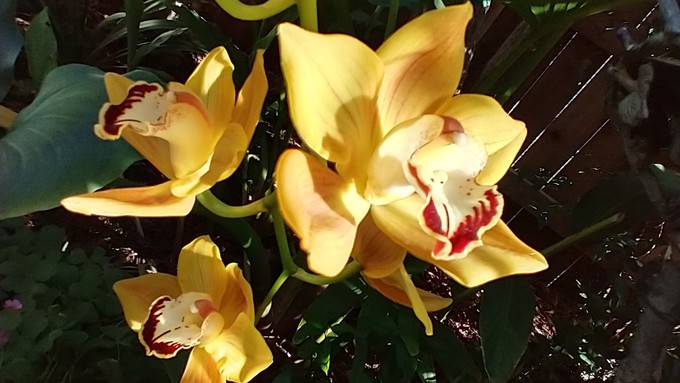
Sacramento Valley Cymbidium Society offers beautiful plants grown by members

Cymbidiums love living outdoors in Sacramento. They thrive in bright, filtered shade. Debbie Arrington
Here’s a chance to take home some exquisite outdoor orchids while helping a local club.
On Wednesday, June 28, the Sacramento Valley Cymbidium Society will host its annual orchid auction and end of season celebration at Shepard Garden and Arts Center. The public is invited. Admission and parking are free.
Doors open at 6:30 p.m. and the meeting starts at 7 p.m. Get there early to register for the auction.
Under club rules, only SVCS members can bid in the auction. Not a member? Not a problem! New members can join at the door.
SVCS president Jeff Trimble, a renowned orchid judge, will serve as auctioneer. The plants to be auctioned were grown and donated by local club members. All sales benefit the society and help the club cope with rising rent and other costs. (Checks or cash, please.)
Since the plants were locally grown, these cymbidiums should be well acclimated to life in Sacramento.
Cymbidium orchids are among the easiest to grow and get to rebloom. Native to the foothills of the Himalayas, they can take some cold (but not frost) as well as heat. They love living outdoors most of the year in Sacramento and thrive in our climate. After plants spend a summer outside, cold nights in fall spur the development of new flower spikes.
The key to cymbidium success: Water, light and nutrients. They need frequent watering during their summer growing season and prefer bright shade with filtered sun. Direct, full sun will burn their leaves.
Learn a lot more during Wednesday’s meeting and auction.
Shepard Center is located at 3330 McKinley Blvd., Sacramento, in McKinley Park.
For more details: www.sgaac.org, https://www.facebook.com/sacramentocymbidiums or email SacCymSoc@yahoo.com.
Comments
0 comments have been posted.Sacramento Digs Gardening to your inbox.
Food in My Back Yard Series
May 6: Maintain soil moisture with mulch for garden success
April 29: What's (already) wrong with my tomato plants?
April 22: Should you stock up on fertilizer? (Yes!)
April 15: Grow culinary herbs in containers
April 8: When to plant summer vegetables
April 1: Don't be fooled by these garden myths
March 25: Fertilizer tips: How to 'feed' your vegetables for healthy growth
March 18: Time to give vegetable seedlings some more space
March 11: Ways to win the fight against weeds
March 4: Potatoes from the garden
Feb. 25: Plant a fruit tree now -- for later
Feb. 18: How to squeeze more food into less space
Feb. 11: When to plant? Consider staggering your transplants
Feb. 4: Starting in seed starting
Sites We Like
Garden Checklist for week of May 11
Make the most of the lower temperatures early in the week. We’ll be back in the 80s by Thursday.
* Plant, plant, plant! It’s prime planting season in the Sacramento area. Time to set out those tomato transplants along with peppers and eggplants. Pinch off any flowers on new transplants to make them concentrate on establishing roots instead of setting premature fruit.
* Direct-seed melons, cucumbers, summer squash, corn, radishes, pumpkins and annual herbs such as basil.
* Harvest cabbage, lettuce, peas and green onions.
* In the flower garden, direct-seed sunflowers, cosmos, salvia, zinnias, marigolds, celosia and asters. (You also can transplant seedlings for many of the same flowers.)
* Plant dahlia tubers.
* Transplant petunias, marigolds and perennial flowers such as astilbe, columbine, coneflowers, coreopsis, dahlias, rudbeckia and verbena.
* Keep an eye out for slugs, snails, earwigs and aphids that want to dine on tender new growth.
* Feed summer bloomers with a balanced fertilizer.
* For continued bloom, cut off spent flowers on roses as well as other flowering plants.
* Add mulch to the garden to maintain moisture. Mulch also cuts down on weeds. But don’t let it mound around the stems or trunks of trees or shrubs. Leave about a 6-inch-to-1-foot circle to avoid crown rot or other problems.
* Remember to weed! Pull those nasties before they set seed.
* Water early in the day and keep seedlings evenly moist.